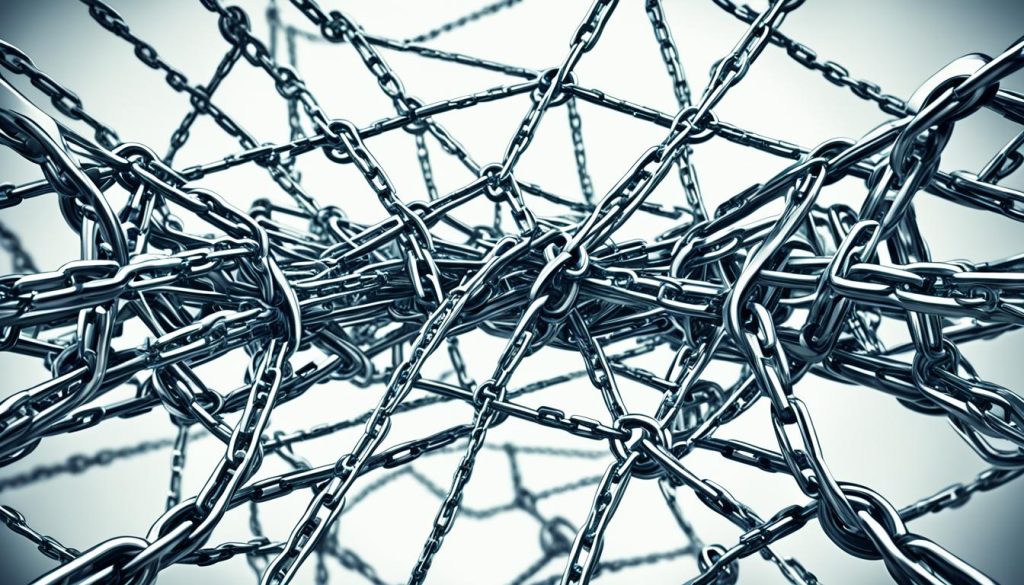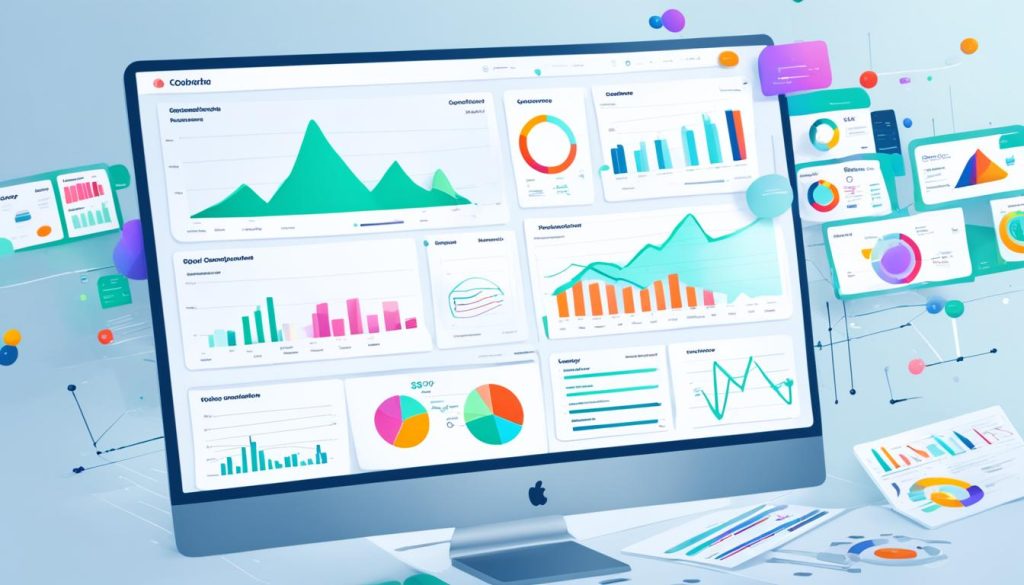Using professional SEO services can greatly boost a website’s success. Experts implement top-notch SEO strategies and improve content. They often publish articles each week. These pieces are packed with useful internal links. This not only updates the site regularly but also strengthens its framework. It helps search engines recognise and rank the website higher.
Key Takeaways
- Integrating articles with strategic internal links can improve SEO best practices.
- Weekly content updates help in the continuous content optimisation of the website.
- Effective link building within articles can enhance the overall site structure.
- Regular updates improve search engine recognition, leading to better rankings.
- Internal links support the distribution of link equity across web pages.
What Are Internal Links?
Internal links are vital for good site navigation and onsite SEO. They are that link pages within your own website, unlike external links that point elsewhere.
When placed well, these make better and ensure a smooth experience for users.
Definition of Internal Links
Internal links show up as and are key for . They do two things. They better by showing how your site is structured. And, they make it easier for visitors to explore your site.
These links connect pages within your website. This boosts your domain’s SEO strength.
Examples of Internal Links
You’ll find internal links in blog posts. They guide readers to more information or detailed guides. Navigation menus and footer links are also crucial.
They help with , making it simple for users to find important pages. Good improves the site’s SEO and user experience.
- Blog post links
- Navigation menus
- Footer links
The Importance of Internal Links for SEO

Internal links are essential for boosting your site’s SEO. They help with site navigation and spread PageRank. These links are key to making your page more visible and highly ranked. Let’s look at the main ways internal links help with SEO.
Improving Site Crawlability
Internal links create paths for search engines to find and index your content. This is known as Googlebot navigation. It allows Googlebot to go through your site easily.
Having better crawlability lets search engines understand your content’s layout. This ensures all pages are indexed and can be ranked.
Passing Authority Between Content Pages
Placing internal links wisely can share PageRank authority among pages. This means linking from high-authority pages to those with less authority. By doing this, you spread SEO benefits across your site.
This method boosts the value of individual pages. It also makes your site’s structure stronger. Ultimately, this leads to better SEO results.
How Internal Linking Supports User Navigation
Internal linking makes navigating a website easier. It connects pages smoothly, helping users stay on the site longer. This approach boosts the site’s usability and keeps visitors interested.
These links act like signs, showing users where to go next. This easy flow reduces bounce rates and encourages a longer visit. Visitors often see more pages, enjoying their time and maybe deciding to convert.
A smart internal linking strategy turns the site into a simple map. Here are its advantages:
- Enhanced Engagement: Internal links get users to explore more, taking them deeper into the site.
- Improved Usability: These links offer clear directions, making it simpler for users to find what they need.
- Increased Visit Duration: Smooth links lead users through pages, making them stay and read more.
Internal linking is key to a positive user experience. It creates a site that’s easy to use and keeps visitors coming back for more.
Different Types of Internal Links

It’s important to know about the different internal links for a good website structure. Each kind helps with navigation and makes the site better for users. Here are the main types you should know:
Navigational Links
Navigational links are found in the menu. They lead users to key sections like the homepage or contact page. These links make it easy for people to find what they need on the site.
Footer Links
Footer links show up on every page. They’re in the site’s footer and link to pages like the privacy policy or terms of service. Having these links helps users find important information anytime.
Sidebar Links
Sidebar links give extra navigation choices. They are often on blog pages or resource sections. These links help users find more content and improve their experience on your website.
Contextual Links
Contextual links are within the text body. They link related pages, smoothly leading users from one to another. Using these links makes your content easier to read and boosts your SEO.
Building a Successful Internal Linking Strategy
An effective internal linking strategy can boost your site’s SEO. It includes critical steps that enhance content marketing, keyword research, and link strength.
Identifying Pillar Pages
Pillar pages are key pieces of content on broad topics. They act as hubs for related subtopics, linking them together. This creates a seamless SEO strategy. Focus on parts of your website with lots of information. They should support various topic clusters.
Creating Topic Clusters
After choosing pillar pages, you must make topic clusters. These are articles that explore parts of the broad topics on your pillar pages. They link all related content, improving user experience and your site’s keyword research. This helps spread link equity around your site, making your SEO strategy stronger.
Choosing the Right Anchor Text
Choosing the right anchor text is crucial. It should give a clear picture of the linked page’s content to users and search engines. Make sure the anchor text is relevant, descriptive, and fits naturally in the text. It improves content marketing and SEO by making each page more relevant and understood.
Tools for Managing Internal Links

Managing internal links well is key for a top-notch website. Thanks to advanced SEO tools, the process is now simpler. These tools help find linking opportunities, show the site’s layout, and track how well internal links are doing.
Link analysis tools give deep views into the spread of internal links across a website. They highlight which pages are well-connected and which are not. This helps ensure links are well distributed, boosting the site’s health.
Platforms like WordPress, Joomla, and Drupal help with internal links. They come with built-in options or add-ons for easy link handling. These systems keep the site’s structure neat and user-friendly.
It’s vital to keep an eye on internal links over time. Using SEO software for regular checks makes sure links work as they should. This lifts search engine ranks and improves how users interact with the site.
- SEO software – Tools like Moz, Ahrefs, and SEMrush assist in internal link management.
- Link analysis tools – Use Sitebulb or Screaming Frog for in-depth link reviews to find weak spots.
- Content management systems – Systems like WordPress make adding and editing internal links easier.
- Website optimisation – Keep your site in top shape with regular link check-ups and tracking.
Using these tools can make your site stronger and easier to move around in. This leads to more engagement and better conversion rates.
Common Internal Linking Issues and How to Fix Them
Having problems with internal linking can really affect your site’s SEO. Two big problems are orphaned content and broken links. It’s crucial to fix these issues by correcting errors and doing content audits regularly. This keeps your site well-organised.
Fixing Orphaned Content
Orphaned content means pages with no links from your website. They are hard for search engines to find and index. To solve this, first find these pages with a content audit. Next, link them to relevant parts of your site. This helps search engines find them and boosts your site’s SEO.
Avoiding Broken Links
Broken links stop users and search engines, hurting your site’s SEO and easy use. To avoid this, check for broken links often and fix them quickly. This makes your site easy to navigate and keeps the SEO health strong.
Benefits of Weekly Articles with Internal Links
Adding new content weekly with internal links can boost your SEO. Fresh articles keep your audience coming back for more. They make your website’s content strategy stronger and improve performance.
Updating your content regularly keeps your site interesting and relevant. It draws in both new and returning visitors. Using internal links helps people navigate your site better. This leads them to discover more content and stay longer.
Regular updates with internal links are crucial for spreading link equity. They make your new content more visible online, boosting SEO quickly. By combining consistent content updates with smart linking, your site’s search ranking and user experience will greatly improve.
SEO Services – Articles with Internal Links Weekly
Professional SEO services boost a website’s performance by updating articles weekly. These updates include strategic internal links. This keeps the site’s content new and interesting, drawing in visitors. It also improves the site by linking important pages well.
With regular updates, internal links help maintain the site’s structure. This makes the website more robust and user-friendly. Keeping content fresh and linking wisely spreads SEO benefits throughout the site.
Professional SEO services streamline site navigation with well-placed internal links. These updates improve the site’s performance right away and in the future. They align content with the right keywords, aiding in better search engine rankings.
To sum up, weekly updates and internal linking are key for SEO and user experience. This continuous effort is crucial in the digital world. It bolsters content and link management, a must-do for better SEO performance.
Increasing Your Site’s Authority with Internal Links

Using internal links cleverly can boost your site’s domain authority. These links create a network that shows your site as credible to search engines. It makes your site easier to navigate and shows your content as quality, deserving higher rankings.
To boost your website’s credibility, an organised interlinking strategy is key. It helps search engines see the full range of your content. This increases your site’s authority. Having quality content with good internal links also boosts user engagement.
When content is easy to access, people stay longer on your site. This makes search engines view your site as more valuable. Internal linking turns your website into a hub of quality content. This is vital for credibility and SEO.
Best Practices for Internal Linking in Blog Posts
Implementing effective internal linking is crucial for enhancing editorial integrity. Engaging readers smoothly is also essential. To do this, picking relevant content and adding links naturally is vital. These practices keep your content valuable for longer and improve the reader’s experience.
Selecting Relevant Signs
The success of internal linking relies on linked content being relevant. When picking pages to link, think about the content value and how it fits the reader’s journey. This boosts reader engagement and keeps your posts editorial integrity high.
- Link to content that complements or goes deeper into the topic.
- Make sure linked pages offer more insights or solutions.
- Avoid links to outdated or irrelevant content, as it lessens the content value.
Integrating Links Naturally
It’s important to weave internal links into your text naturally to maintain editorial integrity and link relevance. When fits into the content well, links seem less forced and more valuable.
- Use contextual anchor text that points clearly to the linked content.
- Don’t overdo linking; keep it balanced to avoid overwhelming readers.
- Links should make the reader engagement better by adding to the story.
Using Internal Links to Boost PageRank
Using internal links wisely is key to improving your website’s PageRank. By spreading link juice across your site, you can boost how search engines view your site.
Search engines use algorithms to understand your website. Smart internal linking tells these algorithms your site is important. This helps your site’s pages get ranked better.
Begin by finding the pages that need more visibility. These are often pages with great content but are not seen much. Sharing link juice from popular pages can improve their visibility.
Follow these tips to get better at internal linking:
- Use clear and relevant anchor text for links
- Check your links often to ensure they work and stay relevant
- Organise your site well to spread link juice effectively
By improving your internal linking, you not only boost your PageRank. You also make your site better for the visitors.
How Internal Links Enhance Topic Clusters
Creating topic clusters helps make your site comprehensive and user-friendly. Internal links connect your content, forming a hub of information. This boosts your site’s authority and helps both users and search engines.
Creating a Content Hub
A content hub gathers related topics in one place, making it easy to explore. By using internal links, you link articles to a main page. This enhances how users experience your site and can improve SEO.
Organising Content for Better User Experience
Internal links improve how users move through your site. They make related content easy to find, leading users on a clear path. This keeps visitors interested and can lower bounce rates. It also shows search engines your site is well-organised and reliable.
